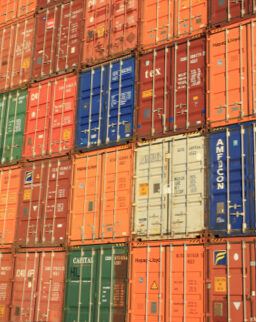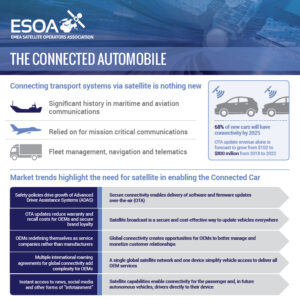An increasing number of people, using an increasing number of connections and applications presents challenges in terms of coverage, capacity, and bandwidth. With that population constantly on the move, expecting seamless connectivity from the air to the ground, satellite and terrestrial networks must be integrated. Specifically, next generation hybrid mobile/satellite connectivity will underpin the world’s future connected transportation infrastructure.
Broadband connectivity via a combination of mobile and satellite is key to enabling full exploitation of the next generation of mobility services for transport – including intelligent cars/smart roads, trains, ships or planes – both manned and unmanned.

Aviation
Satellite communications provide ultimate connectivity for a consistent global experience for the whole aircraft, from safety communications to high-speed broadband and live TV in the cabin. Aviation safety is enabled through data communications with control centres on the ground using the C-band. Communications with the aircraft themselves are enabled using the L-band. They enable a wide range of uses in the cockpit and the cabin. These include safety communications, weather and flight-plan updates, as well as passenger connectivity for email, Internet access, VoIP telephone calls, GSM and SMS messaging.
Satellite communication enables safe and efficient passage of the aircraft to its destination with up-to-date information, including route, air traffic and airline operational information, supporting all key cockpit applications.
Satellite networks play an indispensable role in efficient air traffic management. Ka-band satellites using the Gigahertz frequency spectrum can reach user terminals across most of the populated world. As a result, ATM based satellite networks can be effectively used to provide real time as well as non-real time communications services to remote areas. Satellites offer wide geographic coverage including interconnection of “ATM islands”, multipoint to multipoint communications facilitated by the inherent broadcasting ability of satellites, bandwidth on demand (Demand Assignment Multiple Access (DAMA) capabilities), and an alternative to fiber optic networks for disaster recovery options.


Maritime
The global supply chain of all food/ water/ other supplies is enabled by merchant shipping on all oceans around the world. Thousands of vessels rely on unrivalled end-to-end service availability and coverage for operational communications, safety services provided by satellites and for crew welfare. While maritime satellite links are in L-band, all the feeder links are in the lower C-band 3.4 – 3.6 GHz.
Mobile satellite systems preserve the lives of seafarers, enabling ship to shore communications as well as contributing to the safety of navigation and the vessel itself by enhancing situational awareness. Downloading navigation chart updates over mobile broadband can be achieved via satellite, in addition to exchanging voyage, fuel consumption, weather and other business process data with shore. Mobile satellite communications for ships also enable proper reporting for ships and trawlers who are required to comply with fishing quotas.
Ship tracking and security/anti-piracy capabilities are already advanced through satellite with numerous commercial operators already playing a very active role in protecting the commercial interests of the ship operators through optimised routing. Thanks to satellites one can obtain ship position, receive safety advisory messages, and communicate, including emergency calls, request support from air and receive support to anti-piracy actions.



